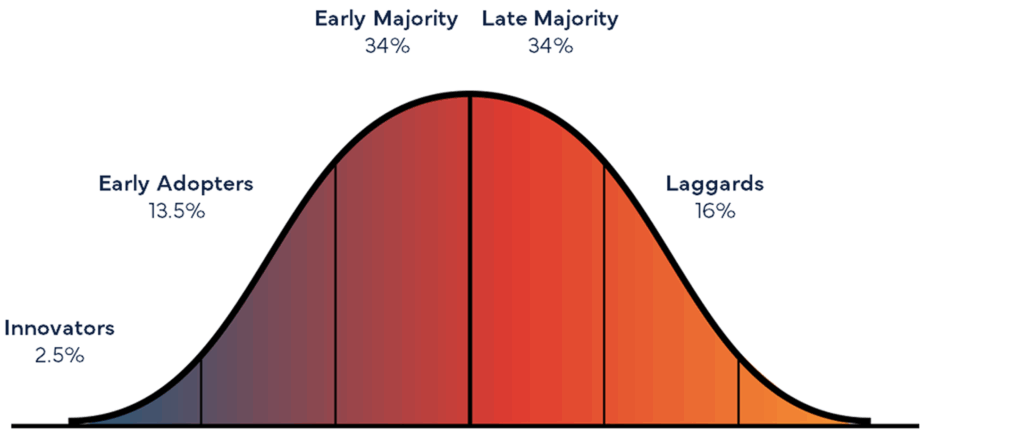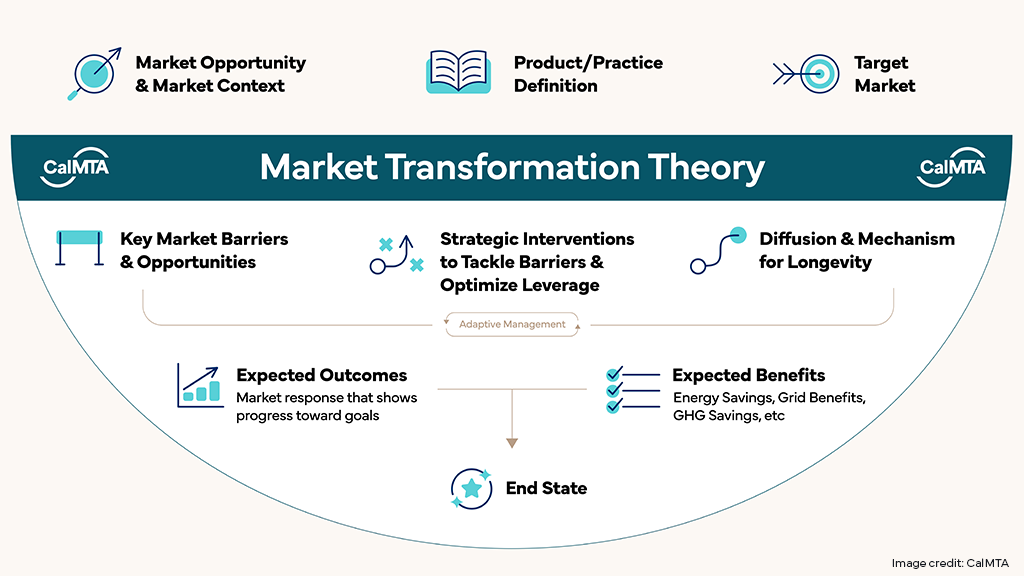Market transformation is a proven strategic process of intervening in a market to create lasting change. In the context of CalMTA’s work, these changes work to deliver cost-effective energy efficiency and support California’s other goals on greenhouse gas (GHG) reduction, workforce development, and equity.

The purpose of market transformation programs is to accelerate diffusion — or market share — of the desired energy-efficient technology or practice. Diffusion is the process by which market adoption spreads over time across consumer groups of innovators and early adopters to a tipping point of acceptance. The diffusion of innovation curve that illustrates this concept (see graph above) was developed by E.M. Rogers.
By reducing barriers to the adoption of specific energy-efficient technologies or practices and capitalizing on market opportunities, a market transformation approach can yield measurable benefits that remain long after active market interventions have ended.

The process of developing a market transformation initiative (MTI) begins with identifying the market opportunity and context for an energy efficiency technology or practice that is well-suited for a market-level intervention. Such an intervention would result in transformative change that removes structural barriers preventing growth in market share. These changes, once realized, result in large-scale, long-term impact.
After identifying the opportunity and context, we refine the product or practice definition to target the specific technology or practices that will be most responsive to strategic interventions and yield the highest-value benefits.
Clearly defining the MTI target market is as important as clearly defining the product or practice. It allows us to focus on segments with the greatest potential for leverage and influence. Based on this refinement, we can then understand the opportunities to accelerate market adoption and a growth trajectory. These first initial steps help us better understand what we’re trying to change, while the next level of activity helps us better understand how to transform the market.
Market characterization research informs development of a market transformation theory, which guides the MTI’s development and implementation, and informs a logic model: a market-wide visual presentation of specific barriers and opportunities and how strategic interventions in the market would affect sustained change.
The logic model’s strategic interventions look to overcome market barriers. It also includes key leverage points that can support the changes that will allow the targeted product or practice to become a regular or even preferred choice for consumers and businesses. Leverage points can include incentives offered by other programs, motivated market actors, voluntary regulatory requirements, or product ratings such as the ENERGY STAR® label.
MT theory also maps out the potential for market diffusion (increase in market adoption) and a mechanism for longevity of market changes. That can be locking in the change through codes or standards or by growing market share to a level that creates sustained demand for a product or practice.
As the MTI is deployed in the market and we begin to see the expected outcomes and benefits realized, we track our progress through independent third-party evaluation against established market progress indicators (MPIs). An adaptive management process allows us to respond to ongoing changes in the market landscape, the product or practice, and the target market, as well as what we learn through our metrics and data.
The changing market will also provide important benefits to Californians. These benefits include energy savings, grid flexibility, and decreased greenhouse gas emissions, all of which are crucial to California achieving its energy and climate goals.
MPIs and evaluation findings help us determine when barriers have been removed or reduced enough that the market will continue to transform without further intervention— either locked in as a code or standard or through sustained market share. At that point, the MTI reaches its end state and investment in the MTI ceases.
CalMTA currently has seven market transformation ideas moving through the market transformation initiative (MTI) development process. These ideas have high potential to create market-level change that drives adoption of products and practices that deliver lasting, cost-effective efficiency.
The Room Heat Pumps MTI was approved for immediate implementation while the Induction Cooking MTI received conditional approval and will move to implementation after modification and submission via a Tier 2 Advice Letter to the CPUC. The other five ideas are currently in Phase II: Program Development.
CalMTA ‘s market transformation initiatives aim to help California achieve its climate goals for energy efficiency, decarbonization, workforce development, and equity.
CalMTA recognizes the historical inequities of efficiency investment and is using an equity lens in our approach to developing a market transformation portfolio for California that delivers benefits to environmental and social justice communities.

The California Market Transformation Administrator (CalMTA) develops and manages market transformation initiatives in the state to reduce energy use and reduce greenhouse gas (GHG) emissions.


CalMTA follows a rigorous process for reviewing, scoring, and then developing relevant, timely market transformation initiatives. The process supports market transformation initiative creation from concept to program development to market deployment, as well as the eventual exiting of the market.

Learn more about CalMTA’s planning and research on energy efficient technologies and our work to build California’s market transformation portfolio, and access quarterly and annual progress reports.
Want to learn more? Join our mailing list to stay informed about upcoming meetings and events, RFI and RFP announcements, and more.
We welcome your questions and suggestions.
Have questions or comments about CalMTA?
Use our contact form to connect with us, or reach out to:
CalMTA
Resource Innovations
719 Main Street, Suite A
Half Moon Bay, CA, 94019
(888) 217-0217
All Advisory Board meetings are open for public comment. If you’re unable to share your thoughts during an MTAB meeting, access our comment form to to provide your opinion.
Want to learn more? Sign up for our mailing list to receive twice-monthly updates about upcoming events, including Advisory Board meetings, informational webinars, important RFI deadlines, and more.